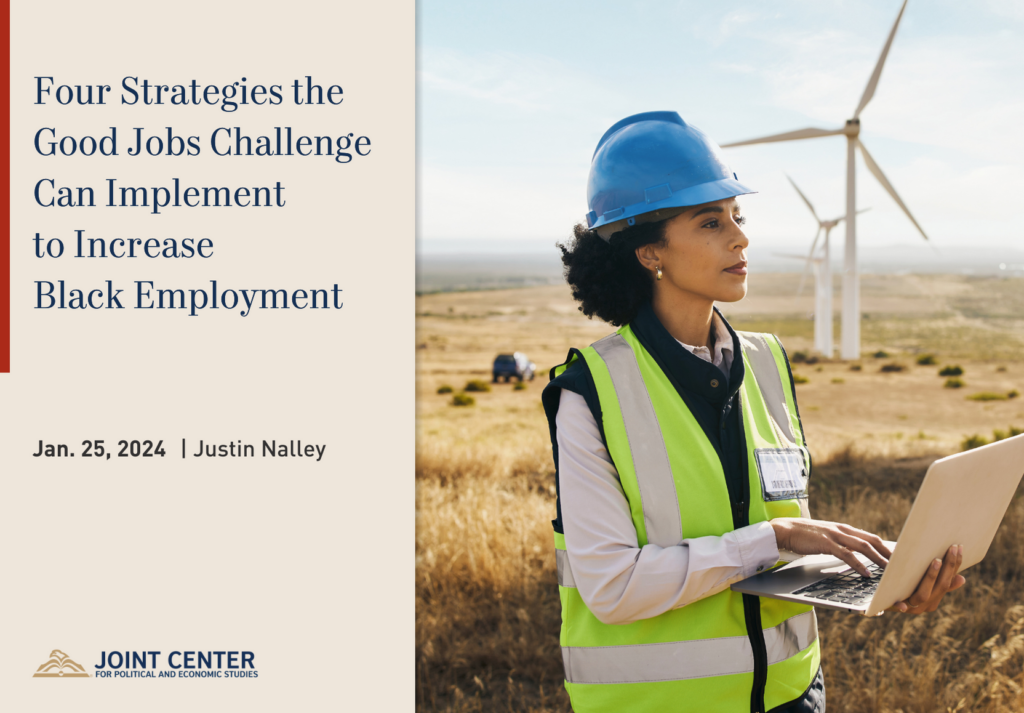Workforce Policy

Four Strategies the Good Jobs Challenge Can Implement to Increase Black Employment
Passed in March 2021, the American Rescue Plan Act (ARPA) allocated $500 million to the U.S. Economic Development Administration (EDA), a bureau within the Department of Commerce, to establish the Good Jobs Challenge.1 The Good Jobs Challenge is a strategic initiative that brings American workers and employers together through workforce training systems.2 The EDA awarded grants to 32 industry-led workforce training partnerships in 31 states and Puerto Rico to place 50,000 American workers into high-quality jobs in emerging sectors.3 Grants range from $2-23 million across 15 industries, including healthcare, information technology, manufacturing, and energy.4 The Good Jobs Challenge has entered its award performance phase, and projects will be completed by May 2027.5
1). Implement Robust Data Collection
To leverage the power of the workforce system, employers, colleges, organizations, and governments participating in the challenge must collect robust data during program implementation to capture employment progress and outcomes. This includes collecting participant-level outcomes data disaggregated by race, socioeconomic status, industry, housing status, transportation access, and job retention. Comprehensive data collection methods support Black workers’ placement in training opportunities that advance their career goals, promote job quality and economic mobility, and reveal which programs retain and effectively serve Black participants.8 The complexity of the regional workforce system requires that specific entities be tasked with data collection and analyses. Each regional workforce training system includes a “System Lead Entity” and several sectoral partnerships. The lead entity is responsible for spearheading the regional system programs and activities of several sectors/industries. Each sectoral partnership includes a “Backbone Organization,” which is the lead convener within a single-sector partnership. As the lead agency for the sector partnership, the Backbone Organization should coordinate and lead data collection efforts.
2). Create and Enforce Accountability Measures
The EDA must hold Good Jobs Challenge grant recipients accountable for recruiting, training, and placing Black workers in high-quality jobs. The EDA defines a high-quality job as “a job that exceeds the local prevailing wage for an industry in the region, includes basic benefits (e.g., paid leave, health insurance, retirement/savings plan) and/or are unionized, and helps the employee develop the skills and experiences necessary to advance along a career path.”9 The EDA is not required to provide economic development based on race under The Public Works and Economic Development Act of 1965. However, the Biden administration issued an executive order to advance racial equity for underserved communities.10 The EDA can refer to this order to enforce accountability for the Good Jobs Challenge grantees to meet equitable process, output, and outcome metrics in their grant agreements and impose penalties for non-compliance per agency guidelines.
3). Promote Intragovernmental Partnerships
To enhance effectiveness, training systems must coordinate with federal public assistance programs. Agencies, such as the Departments of Social Services, can be involved in regional workforce training systems but are not required strategic partners.11 The workforce system can alleviate hardship for people receiving public assistance by providing employment opportunities for economic mobility. Because Black families are disproportionately represented in assistance — having a recipiency rate of 32.7 percent compared to 14 percent of white families12 — each regional workforce training system should partner with the Supplemental Nutrition Assistance Program, Medicaid, Women, Infants, and Children and Temporary Assistance for Needy Families government representatives to refer recipients to high-quality workforce training programs.13 The Good Jobs Challenge supports these system partnerships by providing technical assistance during program development, design, and implementation.
4). Monitor Occupational Segregation
Finally, the EDA must monitor occupational segregation for Black workers. Occupational segregation happens when workers of a demographic are overrepresented or underrepresented in a particular job.14 Racialized discrimination, biases, and social networks play a role in training and hiring, which blocks Black workers from specific positions.15 Among the sectors prioritized in the Good Jobs Challenge, Black workers are underrepresented in high-paying fields, such as information technology and financial services, but overrepresented in lower-paying healthcare support positions.16 The EDA must analyze job placement data alongside labor market statistics and provide technical assistance to grantees to prevent occupational segregation in current and emerging industries. For example, the Maryland Department of Labor, a Good Jobs Challenge grantee, is leading efforts to establish the state as the country’s premiere destination for Offshore Wind (OSW) training, fabrication, and employment. OSW is an emerging industry comprising various skilled trades such as welding, advanced manufacturing, ironworking, construction, and electrical maintenance of turbine substations.17 Black workers are underrepresented in the wind industry overall, making up just seven percent of workers. Black workers nationally make up 12 percent of the workforce.18 In emerging sectors such as offshore wind energy and water resilience, the Good Jobs Challenge must ensure that Black workers are not steered toward entry-level, low-paying opportunities in these new fields by utilizing federal non-discrimination laws.19
Endnotes
1 H.R.1319 - 117th Congress (2021-2022): American Rescue Plan Act of 2021. (Washington, DC, Mar 11, 2021).
2 United States Department of Commerce, “EDA Awards $3 Billion in American Rescue Plan Funding for Transformative Economic Development Projects Across the Country” (Washington, DC, Oct. 3, 2022).
3 U.S. Department of Commerce, Good Jobs Challenge Fact Sheet (Washington, DC, Aug. 3, 2022).
4 U.S. Department of Commerce, Good Jobs Challenge Fact Sheet (Washington, DC, Aug. 3, 2022).
5 U.S Department of Commerce, Economic Development Administration, Good Jobs Challenge Webinar. (Washington, DC, Aug. 12, 2021). The period of performance ends May 31, 2027.
6 U.S. Bureau of Labor Statistics. Monthly Table: Employment Status by race and Hispanic ethnicity – Dec 2023. (Washington, DC, Dec. 2023). The employment rate of Black workers was 5.2% compared to 3.5% for white workers.
7 U.S. Department of Commerce, “American Rescue Plan Act Good Jobs Challenge Notice of Funding Opportunity.” (Washington, DC, Dec. 28, 2021), p. 14.
8 Joint Center for Political and Economic Studies. “Improving Training Evaluation Data to Brighten the Future of Black Workers.” (Washington, DC, Mar. 30, 2022), p. 14.
9 U.S. Economic Development Administration. American Rescue Plan Good Jobs Challenge- Frequently Asked Questions. (Washington, DC, Aug. 15, 2022).
10 Executive Order No. 14091 of Feb 16, 2023.
11 U.S. Department of Commerce, “American Rescue Plan Act Good Jobs Challenge Notice of Funding Opportunity.” (Washington, DC, Dec. 28, 2021), p. 4.
12 U.S. Department of Health and Human Services. (2022, March). “Welfare Indicators and Risk Factors, 21st Report to Congress,” (Washington, DC, March 2022), Appendix Table 2 Indicator 1: Dependency and Recipiency Rates.
Recipiency is defined as living in a family with receipt in any amount for AFDC/TANF, SSI, or SNAP during the year.
13 Federal public assistance programs: Supplemental Nutrition Assistance Program, Medicaid, Women, Infants and Children (WIC), and Temporary Assistance for Needy Families. The federal poverty guideline for 2022 is $27,750 for a family of 4. U.S. Federal guidelines determine eligibility for specific programs; not all programs listed use the guidelines.
14 Marina Zhavoronkova, Rose Khattar, and Mathew Brady. “Occupational Segregation in America,” (Washington: Center for American Progress, DC, March 29, 2022).
15 Marina Zhavoronkova, Rose Khattar, and Mathew Brady. “Occupational Segregation in America,” (Washington: Center for American Progress, DC, March 29, 2022).
16 U.S. Bureau of Labor Statistics, Labor Force Statistics from the Current Population Survey, (Washington, DC, Jan. 20, 2022).
17 Maryland Department of Labor, Good Jobs Challenge Project Narrative, (Maryland, August 2022), p. 6.
18 U.S. Department of Energy, “United States Energy and Employment Report 2022”, (Washington, DC, June 2022), p. 27.
19 Marina Zhavoronkova, Rose Khattar, and Mathew Brady., “Occupational Segregation in America,” (Washington: Center for American Progress, DC, March 29, 2022).

